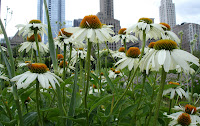
When used in a garden, white can enhance the colors of nearby plants. Just as black can highlight neighboring colors in a painting, think of
Mondrian or
Max Beckman, white plants call attention to their neighbors. And when the garden is a riot of color, white blooms give the eye a place to rest, to distinguish one color from another.
 Liatris spicata
Liatris spicata 'Alba' (White Blazing Star) can be found in the Light Plate near the Seam, growing among stands of two varieties of Coneflower - 'Orange Meadowbrite' and 'Rubinglow.' Its 3-foot spires stand like sentinels in the garden. Notice how the other variety of
L. spicata, the pink-violet Blazing Star, blends into the background.

New to the garden this year is
Parthenium integrifolium (Wild Quinine or American Feverfew), also blooming in the Light Plate near the White Blazing Star. This plant is a Missouri native that grows well as far north as Wisconsin. When established, this plant will grow to 4 feet, its white, wooly flowers creating a screen to highlight the coneflowers.

In the Meadow, white
Echinacea purpurea 'Green Edge' (Coneflower) blooms at the south end of both the Light and Dark Plates. A delicate ring of green florets at the base of the cone is what gives this plant its name. This sturdy coneflower is shorter than the other varieties planted in the garden, and it makes a nice contrast when interplanted with silvery Rattlesnake Masters.

Up in the Dark Plate, a stand of
Hemerocallis 'Gentle Shepherd' (Daylily) brightens the shade from a Black Locust (
Robinia pseudoacacia 'Chicago Blues') near the Cloud Plaza. A screen of white
Veronicastrum 'Diane' (Culver's Root) will soon flower, adding more highlights to this part of the garden.
As you stroll through the garden today, pay attention to what white plants can do for a garden. Tours begin 10 am at the south end of the Seam.
